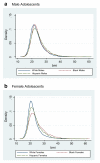Ethnic disparities in adolescent body mass index in the United States: the role of parental socioeconomic status and economic contextual factors
- PMID: 22607746
- PMCID: PMC3695403
- DOI: 10.1016/j.socscimed.2012.03.019
Ethnic disparities in adolescent body mass index in the United States: the role of parental socioeconomic status and economic contextual factors
Abstract
This paper examined the importance of household and economic contextual factors as determinants of ethnic disparities in adolescent body mass index (BMI). Individual-level data from the National Longitudinal Survey of Youth 1997 for the years 1997 through 2000 were combined with economic contextual data on food prices, outlet density and median household income. The Oaxaca-Blinder decomposition method was used to examine the factors that could help explain ethnic disparities in BMI. Ethnic differences in household demographic, parental socioeconomic status (SES), and economic contextual factors explained the majority of the male black-white (63%), male Hispanic-white (78%) and female Hispanic-white (62%) BMI gaps but less than one-half of the female black-white BMI gap (44%). We found that adding the economic contextual factors increased the explained portion of the ethnic BMI gap for both female and male adolescents: the economic contextual factors explained 28% and 38% of the black-white and Hispanic-white BMI gaps for males and 13% and 8% of the black-white and Hispanic-white BMI gaps for females, respectively. Parental SES was more important in explaining the Hispanic-white BMI gap than the black-white BMI gap for both genders, whereas neighborhood economic contextual factors were more important in explaining the male BMI gap than the female BMI gap for both black-white and Hispanic-white ethnic disparities. A significantly large portion of the ethnic BMI gap, however, remained unexplained between black and white female adolescents.
Copyright © 2012 Elsevier Ltd. All rights reserved.
Figures
References
-
- Agency for Healthcare Research and Quality The 2006 national healthcare disparities report (NHDR) 2006 http://www.ahrq.gov/qual/nhdr06/nhdr06.htm.
-
- Auld MC, Powell LM. The economics of obesity: research and policy implications for a Canada–US comparison. In: Beach CM, Chaykowski RP, Shortt S, St-Hilaire F, Sweetman A, editors. Health services restructuring in Canada: New evidence and new directions. John Deutsch Institute for the Study of Economic Policy; Kingston, Ontario: 2006. pp. 305–333.
-
- Auld MC, Powell LM. Economics of food energy density and adolescent body weight. Economica. 2009;76(304):719–740.
-
- Barroso CS, Peters RJ, Johnson RJ, Kelder SH, Jefferson T. Beliefs and perceived norms concerning body image among African–American and Latino teenagers. Journal of Health Psychology. 2010;15(6):858–870. - PubMed
Publication types
MeSH terms
Grants and funding
LinkOut - more resources
Full Text Sources
Medical
Miscellaneous


